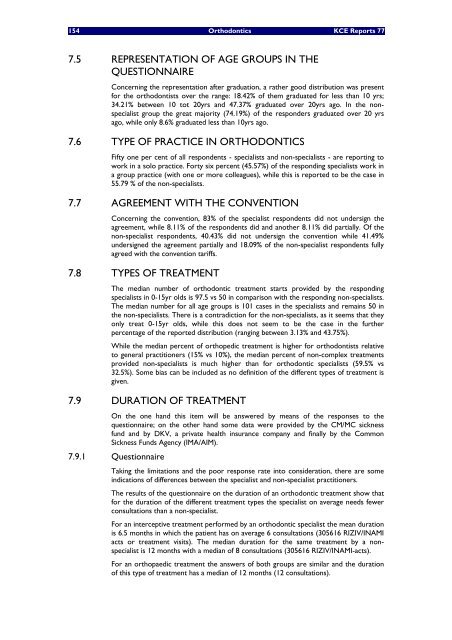The report is available in English with a Dutch summary - KCE
The report is available in English with a Dutch summary - KCE
The report is available in English with a Dutch summary - KCE
You also want an ePaper? Increase the reach of your titles
YUMPU automatically turns print PDFs into web optimized ePapers that Google loves.
154 Orthodontics <strong>KCE</strong> Reports 77<br />
7.5 REPRESENTATION OF AGE GROUPS IN THE<br />
QUESTIONNAIRE<br />
Concern<strong>in</strong>g the representation after graduation, a rather good d<strong>is</strong>tribution was present<br />
for the orthodont<strong>is</strong>ts over the range: 18.42% of them graduated for less than 10 yrs;<br />
34.21% between 10 tot 20yrs and 47.37% graduated over 20yrs ago. In the nonspecial<strong>is</strong>t<br />
group the great majority (74.19%) of the responders graduated over 20 yrs<br />
ago, while only 8.6% graduated less than 10yrs ago.<br />
7.6 TYPE OF PRACTICE IN ORTHODONTICS<br />
Fifty one per cent of all respondents - special<strong>is</strong>ts and non-special<strong>is</strong>ts - are <strong>report</strong><strong>in</strong>g to<br />
work <strong>in</strong> a solo practice. Forty six percent (45.57%) of the respond<strong>in</strong>g special<strong>is</strong>ts work <strong>in</strong><br />
a group practice (<strong>with</strong> one or more colleagues), while th<strong>is</strong> <strong>is</strong> <strong>report</strong>ed to be the case <strong>in</strong><br />
55.79 % of the non-special<strong>is</strong>ts.<br />
7.7 AGREEMENT WITH THE CONVENTION<br />
Concern<strong>in</strong>g the convention, 83% of the special<strong>is</strong>t respondents did not undersign the<br />
agreement, while 8.11% of the respondents did and another 8.11% did partially. Of the<br />
non-special<strong>is</strong>t respondents, 40.43% did not undersign the convention while 41.49%<br />
undersigned the agreement partially and 18.09% of the non-special<strong>is</strong>t respondents fully<br />
agreed <strong>with</strong> the convention tariffs.<br />
7.8 TYPES OF TREATMENT<br />
<strong>The</strong> median number of orthodontic treatment starts provided by the respond<strong>in</strong>g<br />
special<strong>is</strong>ts <strong>in</strong> 0-15yr olds <strong>is</strong> 97.5 vs 50 <strong>in</strong> compar<strong>is</strong>on <strong>with</strong> the respond<strong>in</strong>g non-special<strong>is</strong>ts.<br />
<strong>The</strong> median number for all age groups <strong>is</strong> 101 cases <strong>in</strong> the special<strong>is</strong>ts and rema<strong>in</strong>s 50 <strong>in</strong><br />
the non-special<strong>is</strong>ts. <strong>The</strong>re <strong>is</strong> a contradiction for the non-special<strong>is</strong>ts, as it seems that they<br />
only treat 0-15yr olds, while th<strong>is</strong> does not seem to be the case <strong>in</strong> the further<br />
percentage of the <strong>report</strong>ed d<strong>is</strong>tribution (rang<strong>in</strong>g between 3.13% and 43.75%).<br />
While the median percent of orthopedic treatment <strong>is</strong> higher for orthodont<strong>is</strong>ts relative<br />
to general practitioners (15% vs 10%), the median percent of non-complex treatments<br />
provided non-special<strong>is</strong>ts <strong>is</strong> much higher than for orthodontic special<strong>is</strong>ts (59.5% vs<br />
32.5%). Some bias can be <strong>in</strong>cluded as no def<strong>in</strong>ition of the different types of treatment <strong>is</strong><br />
given.<br />
7.9 DURATION OF TREATMENT<br />
On the one hand th<strong>is</strong> item will be answered by means of the responses to the<br />
questionnaire; on the other hand some data were provided by the CM/MC sickness<br />
fund and by DKV, a private health <strong>in</strong>surance company and f<strong>in</strong>ally by the Common<br />
Sickness Funds Agency (IMA/AIM).<br />
7.9.1 Questionnaire<br />
Tak<strong>in</strong>g the limitations and the poor response rate <strong>in</strong>to consideration, there are some<br />
<strong>in</strong>dications of differences between the special<strong>is</strong>t and non-special<strong>is</strong>t practitioners.<br />
<strong>The</strong> results of the questionnaire on the duration of an orthodontic treatment show that<br />
for the duration of the different treatment types the special<strong>is</strong>t on average needs fewer<br />
consultations than a non-special<strong>is</strong>t.<br />
For an <strong>in</strong>terceptive treatment performed by an orthodontic special<strong>is</strong>t the mean duration<br />
<strong>is</strong> 6.5 months <strong>in</strong> which the patient has on average 6 consultations (305616 RIZIV/INAMI<br />
acts or treatment v<strong>is</strong>its). <strong>The</strong> median duration for the same treatment by a nonspecial<strong>is</strong>t<br />
<strong>is</strong> 12 months <strong>with</strong> a median of 8 consultations (305616 RIZIV/INAMI-acts).<br />
For an orthopaedic treatment the answers of both groups are similar and the duration<br />
of th<strong>is</strong> type of treatment has a median of 12 months (12 consultations).
















